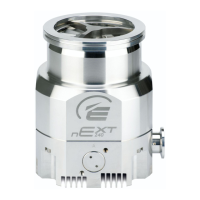B800-00-880 Issue D
Page 46 © Edwards Limited 2013. All rights reserved.
Edwards and the Edwards logo are trademarks of Edwards Limited.
Installation
3.7.6 multi-drop operation
Using multi-drop mode, a single computer system can communicate with more than one nEXT pump. Each nEXT pump
must be assigned its own individual address before it can be fitted into a multi-drop system. The command to assign
the multi-drop address is sent in standard nEXT message format (as detailed in Section 4.1.9).
The message protocol in multi-drop mode is marginally different to that described for serial messages in single pump
systems. The main differences in multi-drop message protocol are detailed below:
All multi-drop commands, queries or replies have the first character #.
All commands, queries and replies contain a header containing the address of the node that the message is
to, followed by the address of the node that the message is from.
There is a delimiter character: (colon) which separates the two multi-drop addresses in the header.
The remainder of the message (command, query or reply) follows the same protocol as already described for
single pump systems.
The wild card address 99 is very useful and means ‘any’ node.
After a nEXT pump has been assigned a multi-drop address, it will ignore any messages in the format for single pumps.
An individual nEXT pump will remain silent and ignore all command messages unless the multi-drop address matches
its own address.
3.8 Connection for mixed parallel and serial operation
The pump can be controlled using parallel interface control inputs and at the same time monitor various pump
parameters using the serial interface. Alternatively, the pump can be controlled using commands sent over the serial
interface while at the same time monitor the normal signal and analogue output over the parallel interface. Figure 17
shows a schematic diagram of a system that demonstrates how to do this. This connection is a hybrid of the parallel
and serial connection which are described in detail in Section 3.6 and 3.7 respectively. Many of the options described
in those sections are available in mixed parallel and serial operation but note that whilst serial enable is active to
enable the serial link, the parallel standby and fail signals are not available. The multi-drop connection shown in
Section 3.7. can also be used with mixed parallel and serial operation.
The pump cannot be controlled using both the parallel and serial interfaces simultaneously. For example, if the pump
is started by sending a start command over the serial interface, the pump cannot then be stopped by using the start
/stop switch on the parallel interface. The pump will ignore the state of the start / stop switch on the parallel
interface. To stop the pump, send a serial stop command. Only when the serial stop command has been received by
the pump can any commands sent via the parallel interface be acted on.
Similarly, if the pump is started by using the start switch on the parallel interface, the pump cannot then be stopped
by sending a stop command over the serial interface. The pump will ignore any start or stop commands received over
the serial interface. To stop the pump, use the parallel stop switch. Only when the pump has been stopped using the
parallel interface switch will any start or stop commands be accepted via the serial interface.
3.9 Vent valve selection, connection and control

